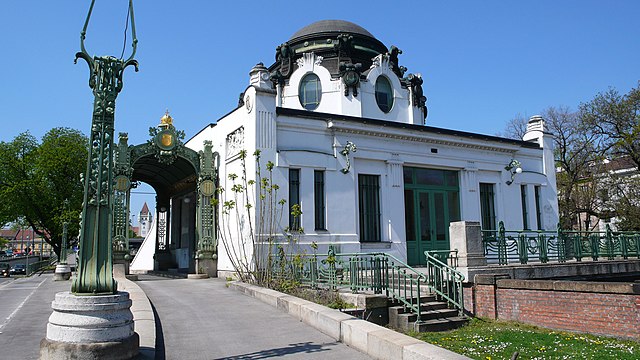
Otto Wagner Hofpavillon at Hietzing
The Pavillon des k.u.k. Allerhöchsten Hofes (Pavilion of the royal and imperial court) in Hietzing near Schönbrunn Palace was built in 1899 to Otto Wagner's design as a special station for the use of the Emperor and members of his court when using the Stadtbahn (metropolitan railway). It was not included in the original plans for the Stadtbahn, but Wagner began construction on his own initiative and was finally able to win over the Minister for Railways, Heinrich von Wittek. In contrast to the other Stadtbahn stations, this pavilion with its cupola has baroque elements, which could be interpreted as a sign of respect for the Emperor on the architect's part. It was built at the inbound end of the platform at the Hietzing station, which opened in 1898; originally there were steps linking it to the public platforms. The Emperor is only known to have used the station on two occasions: in 1899 when he opened the lower Vienna Valley line on the Stadtbahn (between Meidling Hauptstraße and Hauptzollamt) and in April 1902.
Today the imperial waiting room and study and other rooms in the building are on permanent display. Since 2010 the pavilion was closed for restauration. From 2012 to 2014 the pavilion was restaurated according to the design of Otto Wagner. In 21st June 2014 the pavilion wa reopened and is now open to the public as a remote exhibition of the Wien Museum.
Opening Hours (by 04.01.2015)
Saturday and Sunday from 10am to 6pm
Closed on 1.1., 1.5. and 25.12.
For Entrance fees refer to the website of Wien Museum
Otto-Wagner-Hofpavillon in Hietzing
Der Pavillon des k.u.k. Allerhöchsten Hofes in der Nähe von Schloss Schönbrunn in Hietzing wurde 1899 nach Entwürfen von Otto Wagner errichtet und diente dem Kaiser und den Mitgliedern des Hofes als Ein- und Ausstiegsstelle, so diese mit der Stadtbahn reisten. In der ursprünglichen Stadtbahnplanung war dieser Pavillon nicht vorgesehen, aber Otto Wagner hat den Bau auf eigene Verantwortung initiiert und konnte schließlich auch den Eisenbahnminister Heinrich von Wittek überzeugen. Im Gegensatz zu den anderen Stadtbahnstationen weist dieser Pavillon mit Kuppel barocke Stilelemente auf, was als eine Respektbekundung des Architekten Wagner vor dem Kaiser interpretiert werden kann. Der Pavillon wurde am stadtzentrumsseiten Bahnsteigende an die 1898 eröffnete Stadtbahnstation Hietzing angebaut; (später abgetragene) Stiegenabgänge vom Pavillon führten zu diesen öffentlichen Bahnsteigen. Allerdings ist nur von zwei Fällen der Benutzung des Gebäudes durch den Monarchen bekannt, 1899 bei der Eröffnung der unteren Wientallinie der Stadtbahn (Meidling Hauptstraße–Hauptzollamt) und ein weiteres Mal im April 1902.
Heute werden im Pavillon der kaiserliche Wartesalon, das Arbeitskabinett des Kaisers und andere Räume als Dauerausstellung gezeigt. Ab 2010 war der Pavillon wegen Baufälligkeit gesperrt; darüber, wer die Sanierungskosten begleicht, bestand Uneinigkeit zwischen den Wiener Linien als Eigentümer und dem Wien Museum als Nutzer. Von 2012 bis 2014 wurde der Pavillon im Auftrag der Stadt Wien nach dem Originalentwurf von Otto Wagner restauriert. Seit der Eröffnung am 21. Juni 2014 ist er der Öffentlichkeit wieder als Außenstelle des Wien Museums zugänglich.
Öffnungszeiten (Stand: 04.01.2015)
Samstag und Sonntag von 10 bis 18 Uhr
Geschlossen am 1.1., 1.5. sowie 25.12.
Eintrittspreise siehe Website des Wien Museum
Source/Quellen: Wikipedia
Picture/Bild: Wikimedia